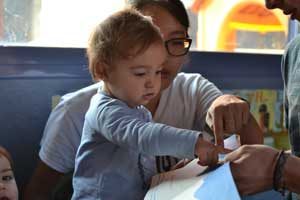
For years, scientists and parents alike have touted the benefits of introducing babies to two languages: Bilingual experience has been shown to improve cognitive abilities, especially problem-solving.
And for infants raised in households where two languages are spoken, that bilingual learning happens almost effortlessly. But how can babies in monolingual households develop such skills?
“As researchers studying early language development, we often hear from parents who are eager to provide their child with an opportunity to learn another language, but can’t afford a nanny from a foreign country and don’t speak a foreign language themselves,” said Naja Ferjan Ramirez, a research scientist at the University of Washington Institute of Learning & Brain Sciences (I-LABS).
A new study by I-LABS researchers, published July 17 in Mind, Brain, and Education, is among the first to investigate how babies can learn a second language outside of the home. The researchers sought to answer a fundamental question: Can babies be taught a second language if they don’t get foreign language exposure at home, and if so, what kind of foreign language exposure, and how much, is needed to spark that learning?
The researchers took their query all the way to Europe, developing a play-based, intensive, English-language method and curriculum and implementing it in four public infant-education centers in Madrid, Spain. Sixteen UW undergraduates and recent graduates served as tutors for the study, undergoing two weeks of training at I-LABS to learn the teaching method and curriculum before traveling to Spain. The country’s extensive public education system enabled the researchers to enroll 280 infants and children from families of varying income levels.
Based on years of I-LABS research on infant brain and language development, the method emphasizes social interaction, play, and high quality and quantity of language from the teachers. The approach uses “infant-directed speech” — often called “parentese” — the speech style parents use to talk to their babies, which has simpler grammar, higher and exaggerated pitch, and drawn-out vowels.
“Our research shows that parentese helps babies learn language,” Ferjan Ramirez said.
Babies aged 7 to 33.5 months were given one hour of English sessions a day for 18 weeks, while a control group received the Madrid schools’ standard bilingual program. Both groups of children were tested in Spanish and English at the start and end of the 18 weeks. The children also wore special vests outfitted with lightweight recorders that recorded their English learning. The recordings were analyzed to determine how many English words and phrases each child spoke.
The children who received the UW method showed rapid increases in English comprehension and production, and significantly outperformed the control group peers at all ages on all tests of English. By the end of the 18-week program, the children in the UW program produced an average of 74 English words or phrases per child, per hour; children in the control group produced 13 English words or phrases per child, per hour.
Ferjan Ramirez said the findings show that even babies from monolingual homes can develop bilingual abilities at this early age.
“With the right science-based approach that combines the features known to grow children’s language, it is possible to give very young children the opportunity to start learning a second language, with only one hour of play per day in an early education setting,” she said. “This has big implications for how we think about foreign-language learning.”
Follow-up testing 18 weeks later showed the children had retained what they learned. The English gains were similar between children attending the two schools serving predominantly low-income neighborhoods and the two serving mid-income areas, suggesting that wealth was not a significant factor in the infants’ ability to learn a foreign language. Children’s native language (Spanish) continued to grow as they were learning English, and was not negatively affected by introducing a second language.
“Science indicates that babies’ brains are the best learning machines ever created, and that infants’ learning is time-sensitive. Their brains will never be better at learning a second language than they are between 0 and 3 years of age,” said co-author Patricia Kuhl, co-director of I-LABS and a UW professor of speech and hearing sciences.
The results, Kuhl said, have the potential to transform how early language instruction is approached in the United States and worldwide:
“Parents in Madrid, in the United States and around the world are eager to provide their children with an opportunity to learn a foreign language early. The U.S. census shows that 27 percent of America’s children under the age of 6 are now learning a language other than English at home. While these children are fully capable of learning both their parents’ language and English, they often do not have adequate exposure to English prior to kindergarten entry and as a result, often lag behind their peers once they enter school,” she said.
“I-LABS’ new work shows we can create an early bilingual learning environment for dual-language learners in an educational setting, and in one hour per day, infants can ignite the learning of a second language earlier and much easier than we previously thought. This is doable for everybody,” Kuhl said.
Source: University of Washington [xyz-ihs snippet=”Adsense-responsive”]






